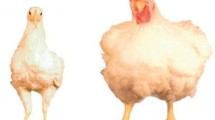Summary
Effects of errors in estimates of the genetic correlation on the accuracy of unrestricted, optimum, and desired gains selection indices were examined experimentally in Tribolium castaneum. Three lines were selected for three generations for pupal weight at 21 days and adult weight at 31 days, using unrestricted (I9), optimum (O9), and desired gains (G9) index selection methods. The genetic correlation between pupal and adult weights in the base population was 0.95. The optimum index was designed to set the response of pupal weight by a fixed amount, while in the desired gains index the responses of pupal and adult weights were specified as being equal to 3∶1. Three other indices were constructed using a deliberately incorrect genetic correlation (0.25), i.e., unrestricted (I2), optimum (O2), and desired gains (G2). Responses observed in unrestricted index lines (I9 versus I2) and optimum index lines (O9 versus O2) did not differ significantly, even though lines I9 and I2 differed in a practical sense. Responses in desired gains index lines (G9 versus G2) differed significantly. Responses obtained for aggregate genotype (pupal weight + adult weight) and for the component traits were greater in line I9 than those obtained in line I2. Responses obtained in the O9 and O2 lines for pupal and adult weights were similar, while those obtained in the G9 and G2 lines were similar for pupal weight but not (P<0.05) for adult weight. Therefore, underestimation of the genetic correlation seems to affect the efficiency of a desired gains index more than that of unrestricted or optimum indices.
Similar content being viewed by others
References
Campo JL, Velasco T (1989) An experimental test of optimum and desired gains indexes in Tribolium. J Hered (in press)
Harris DL (1963) The influence of errors of parameter estimation upon index selection. In: Hanson WD, Robinson HF (eds) Statistical genetics and plant breeding. NAS-NRC, Washington/DC, pp 491–500
Harris DL (1964) Expected and predicted progress from index selection involving estimates of population parameters. Biometrics 20:46–72
Hayes JF, Hill WG (1981) Modification of estimates of parameters in the construction of genetic selection indices (“Bending”). Biometrics 37:483–493
Hazel LN (1943) The genetic basis for constructing selection indexes. Genetics 28:476–490
Heidhues T (1961) Relative accuracy of selection indices based on estimated genotypic and phenotypic parameters. Biometrics 17:502–503
Hill WG, Meyer K (1984) Effects of errors in parameter estimation on efficiency of restricted genetic selection indices. In:Hinkelmann K (ed) Experimental design, statistical methods and genetic statistics. Marcel Dekker, New York, pp 345–368
Hill WG, Thompson R (1978) Probabilities of non-positive definite between-group or genetic covariance matrices. Biometrics 34:429–439
Kempthorne O, Nordskog AW (1959) Restricted selection indices. Biometrics 15:10–19
Lin CY, Pevzner I, Friars GW (1979) Experimental investigation of errors of heritability estimates in index selection. Can J Genet Cytol 21:303–308
Meyer K, Hill WG (1983) A note on the effects of sampling errors on the accuracy of genetic selection indices. J Anim Breed Genet 100:27–32
Pease AHR, Cook GL, Grieg M, Cuthbertson A (1967) Combined testing. Report, Pig Industry Development Authority, Hitchin, Hertfordshire/DA 188
Pesek J, Baker RJ (1969) Desired improvement in relation to selection indices. Can J Plant Sci 49:803–804
Sales J, Hill WG (1976a) Effect of sampling errors on efficiency of selection indices. 1. Use of information from relatives for single trait improvement. Anim Prod 22:1–17
Sales J, Hill WG (1976b) Effect of sampling errors on efficiency of selection indices. 2. Use of information on associated traits for improvement of a single important trait. Anim Prod 23:1–14
Simm G, Smith C, Prescott JHD (1986) Selection indices to improve the efficiency of lean meat production in cattle. Anim Prod 42:183–193
Smith HF (1936) A discriminant function for plant selection. Ann Eugen 7:240–250
Tallis GM (1962) A selection index for optimum genotype. Biometrics 18:120–122
Williams JS (1962) The evaluation of a selection index. Biometrics 18:375–393
Author information
Authors and Affiliations
Additional information
Communicated by K. Sittmann
Rights and permissions
About this article
Cite this article
Campo, J.L., Velasco, T. Experimental study of the influence of errors of genetic correlation estimates on unrestricted, optimum, and desired gains selection indices. Theoret. Appl. Genetics 77, 561–567 (1989). https://doi.org/10.1007/BF00274280
Received:
Accepted:
Issue Date:
DOI: https://doi.org/10.1007/BF00274280




